By: Morgan Putnam, vice president of Solar Analytics
Recently, the idea that we might economically curtail excess renewable energy has gained considerable attention, as discussed in detail here, here, and here.
My experience is that many utility employees quickly realize that the economic curtailment of excess renewable energy isn’t so terribly different from the use of gas peakers. Gas peakers and some other generation assets are designed to be operated with utilization factors well below 100%. In fact, gas peakers are used roughly 5% of the hours in a year. As a result, utility employees appreciate the idea of overbuilding renewables to ensure sufficient capacity when resources are low (relative to load). In this scenario, excess production is spilled when renewable resources are high. This is a practical way to satisfy a grid operator’s fundamental requirement—delivering enough supply to meet demand. Provided the economics work, there’s no reason not to do it.
Some renewable developers are also relatively quick to appreciate the economic benefits of curtailing excess renewable energy. This isn’t surprising as they’ve already been curtailing small amounts of excess renewable energy for a number of years (as I’ll describe below).
But for many – including renewable developers, environmental advocacy organizations and state agencies – the curtailment of renewables is at best a bit odd (why would we throw away renewable energy, don’t we need more of it?), and at worst borders on blasphemy (renewable electrons are precious – haven’t you heard of climate change!). So, for everyone who has yet to embrace economic curtailment, below is my five-step process.
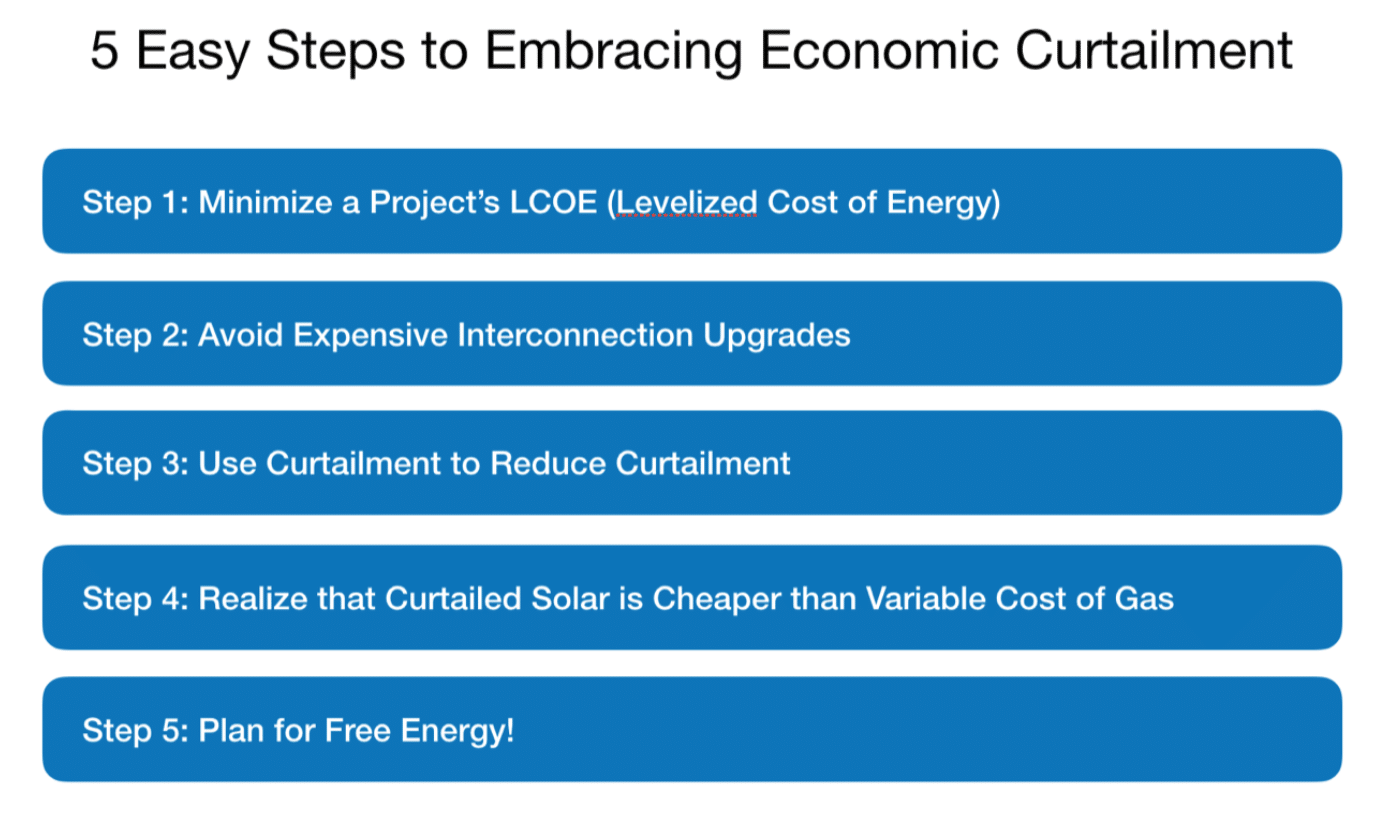
To be clear, embracing economic curtailment does not preclude the use of storage, load-shifting and other technologies to mitigate the need for curtailment. It just means understanding there will be times when curtailing excess renewable energy production will be the most economic option.
Step 1: Minimize a Project’s LCOE (Levelized Cost of Energy)
If you’re a solar or wind developer, the name of the game is minimizing your project’s LCOE. Minimizing a project’s LCOE creates a trade-off between increasing energy production and reducing project costs. This LCOE minimization is why technologies like two-axis solar trackers have yet to be successful: the additional energy production from a two-axis tracker is unable to offset its higher installation and operation costs.
Interestingly, minimizing a project’s LCOE also means designing projects that will have a small amount of energy curtailment. Energy production from solar and wind projects are tied to environmental conditions. Like a bell curve, most hours of the year have environmental conditions that fall near an average-value. However, there are a few hours each year where the environmental conditions are near-perfect for solar or wind production. Solar and wind developers could design their projects to capture energy production during these hours but doing so would drive up their project costs (e.g., stronger wind turbines or larger solar inverters). As a result, solar and wind project developers design a small amount of curtailment into their projects (i.e., wind turbines that feather their blades to capture less wind and solar inverters that clip excess production) during these periods of peak renewable production.
Developers innately understand this form of economic curtailment. For others in the renewable energy space, it is time to start thinking like a developer: minimize the cost of your product and maximize its value to the customer.
Step 2: Avoid Expensive Interconnection Upgrades
In the process of obtaining interconnection approval (aka permission to operate), renewable developers of large projects (> 10 MW) often find themselves needing to minimize a project’s LCOE a second time. At certain locations solar and wind projects can be connected to the grid without any grid upgrades required. However, as renewable penetration grows the addition of more renewable capacity can create conditions where the grid becomes unstable during critical periods. These critical periods are often brief – occurring a few tens of hours a year in total. Here again renewable developers face a choice: cover the cost of expensive grid infrastructure upgrades or allow the utility to curtail a small percent of their annual generation (~1-5%). And as during their internal design phase, renewable developers chose to minimize their LCOE and thus agree to a limited amount of curtailment.
The MN Solar Pathways project explored this issue for community solar projects connecting to the distribution grid with its Enhanced Hosting Capacity Analysis. Notably, the Enhanced Hosting Capacity analysis probed the ability to increase the solar capacity that could be added to a distribution feeder using the following technologies: smart inverters, thermal load shifting, battery storage, and active grid management (curtailment). The study examined four feeders in Minnesota (both rural and urban) and found that in two of the four cases, curtailment offered the most economical solution for increasing a feeder’s hosting capacity.
Working together, developers, utilities and regulators can utilize new technologies to increase renewable hosting capacities (especially for distributed solar) without expensive grid interconnection upgrades. Doing so would be a clear example of economic curtailment.
Figure 1: Modest amounts of curtailment (up to 5% annually) can cost-effectively enable a distribution feeder’s PV capacity limit to be dramatically increased for feeder’s whose capacity is limited by thermal overloading constraints.
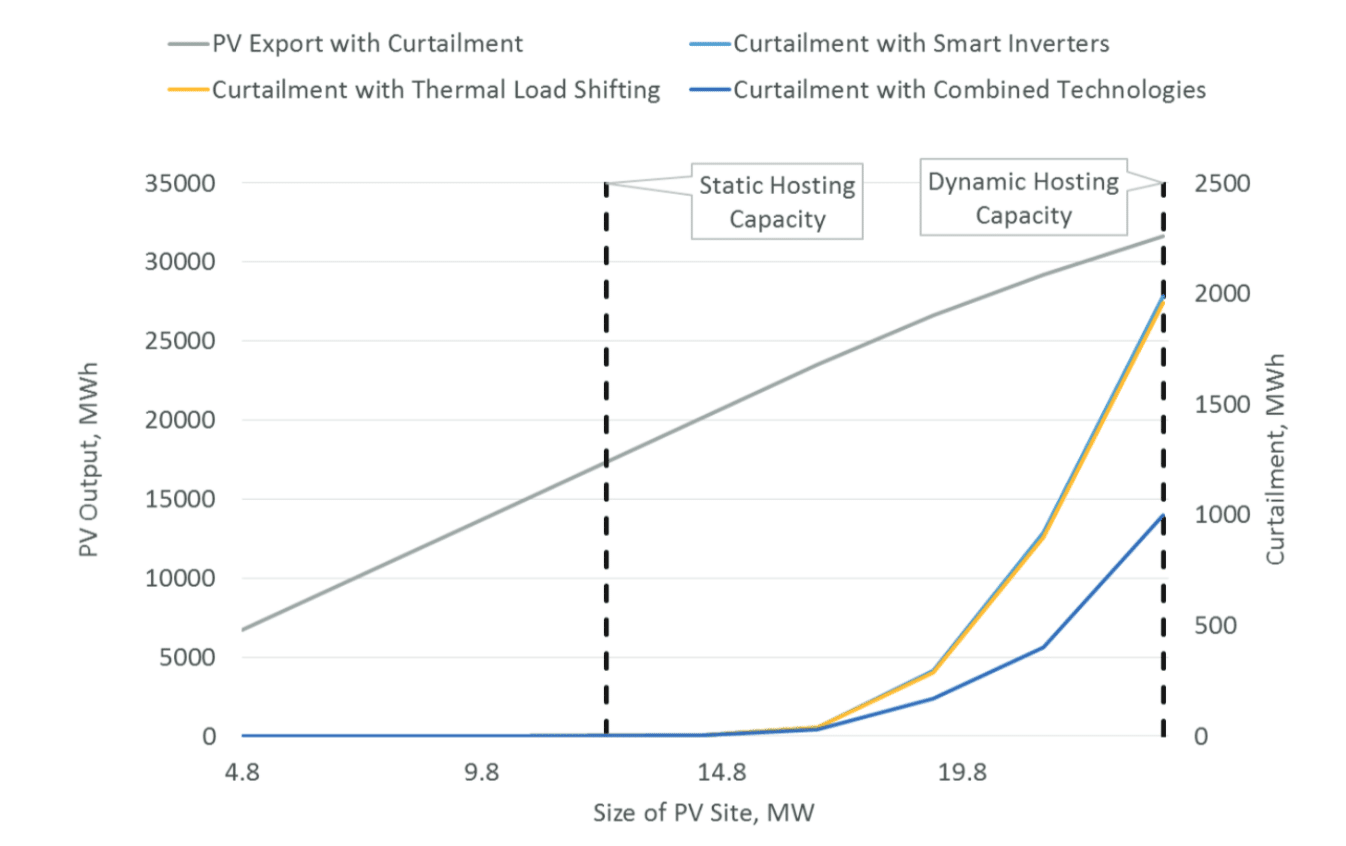
Step 3: Use Curtailment to Reduce Curtailment
Having discussed how project developers are already using a small amount of curtailment to improve project economics, we shift our focus to economics and operation of the grid. Last year, FirstSolar worked with E3 and Tampa Electric Company to demonstrate that operating solar in a flexible manner (with a degree of energy curtailment) delivered a number of system benefits. Notably, their work demonstrated that modest amounts of solar energy curtailment resulted in:
- significant annual production cost savings for the grid;
- reduced thermal commitments and in turn reduced fuel burn and associated emissions; and
- less system-wide solar curtailment.
Yes, you read that last bullet correctly: planning to operate the grid with solar curtailment resulted in less overall solar curtailment. The full report can be found here and overviews of the report can be found here and here.
To actually use curtailment to reduce curtailment, there is much work that needs to be done. Adapting market dispatch rules is a complex and lengthy process involving many stakeholders. All interested parties need to start working together in earnest today. Otherwise, the market dispatch options needed to economically increase renewables beyond 20% penetration won’t be available when we need them.
Figure 2: Annual production cost savings and % of solar curtailment associated with different solar operating modes. Notably, operating the grid with solar curtailment (see Full Flexibility curve) resulted in lower operating costs and less overall solar curtailment than with no or limited solar curtailment (see Must-Take and Curtailable curves).
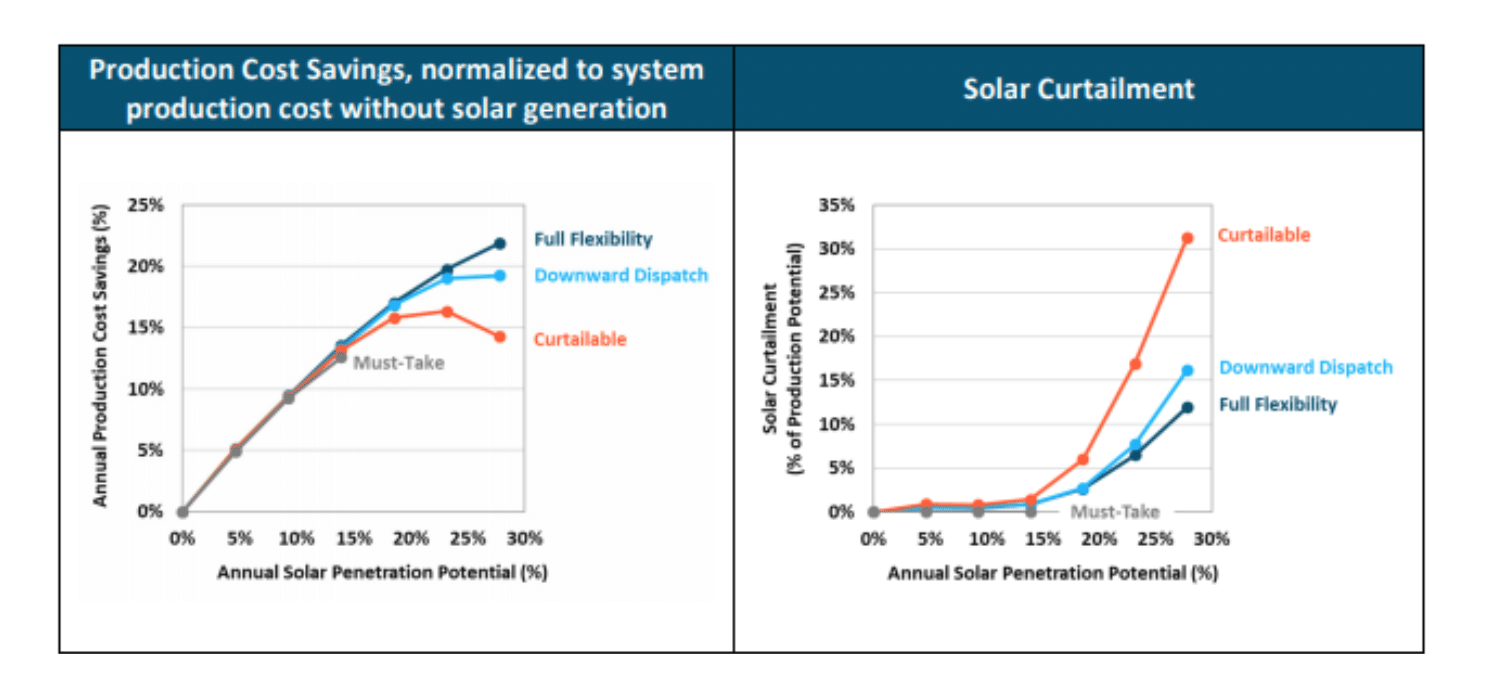
Step 4: Understand Future Cost Structures
Historically, solar developers, renewable advocates and others have been deeply concerned with the curtailment of renewable energy. Ironically, a key implication of falling solar and wind generation costs is the ability to be below the operational cost of natural gas generation, even with modest amounts of solar and wind curtailment.
The figure shown below highlights that curtailing 10% (or even 20%) of annual energy generation has a modest effect on solar and wind generation costs. In the case of wind, annual energy production can be curtailed up to 20% and still fall below the operational cost of natural gas generation. This assumes today’s historically low natural gas prices and a gas delivery cost of $1/MM BTU.
Solar without curtailment is at parity with the operational cost of natural gas generation today (assuming a $3/MM BTU delivered cost of natural gas). As such, it cannot as easily bear the cost of energy curtailment. However, the cost of solar continues to fall at a remarkable pace. Within a few years solar costs will be where wind costs are today, thus enabling the economic curtailment of modest amounts of solar energy without exceeding the operational cost of natural gas generation.
Importantly, all of the analysis above assumes that natural gas generation costs don’t increase with time. Whether due to a re-balancing of natural gas supply and demand, or the addition of a carbon tax, the energy markets forecast that natural gas generation costs will rise as we move into the mid-2020’s.
Being able to curtail renewables and still have their costs fall below the operational cost of natural gas has both an upside and a downside. The upside is that renewables will be able to serve an even greater share of the annual load. The downside is that it will lead to price depression during an increasing number of hours each year.
Developers, financiers, utilities, and regulators should begin to work through the implications of a near/mid-term future where renewables being to drive increasing amounts of price depression. Hawaii’s solution to this future has been to contract for renewable capacity instead of renewable energy. This enables HECO to dispatch solar and wind to deliver the greatest value to the grid. This is also a solution advocated by First Solar. While elegant, Hawaii’s solution works best in bi-lateral markets. Other solutions, are needed for markets where a majority or all of a project’s revenue is derived from energy payments (e.g., ERCOT).
Figure 3: Cost of Solar and Wind Compared with the Operational Cost of Natural Gas.
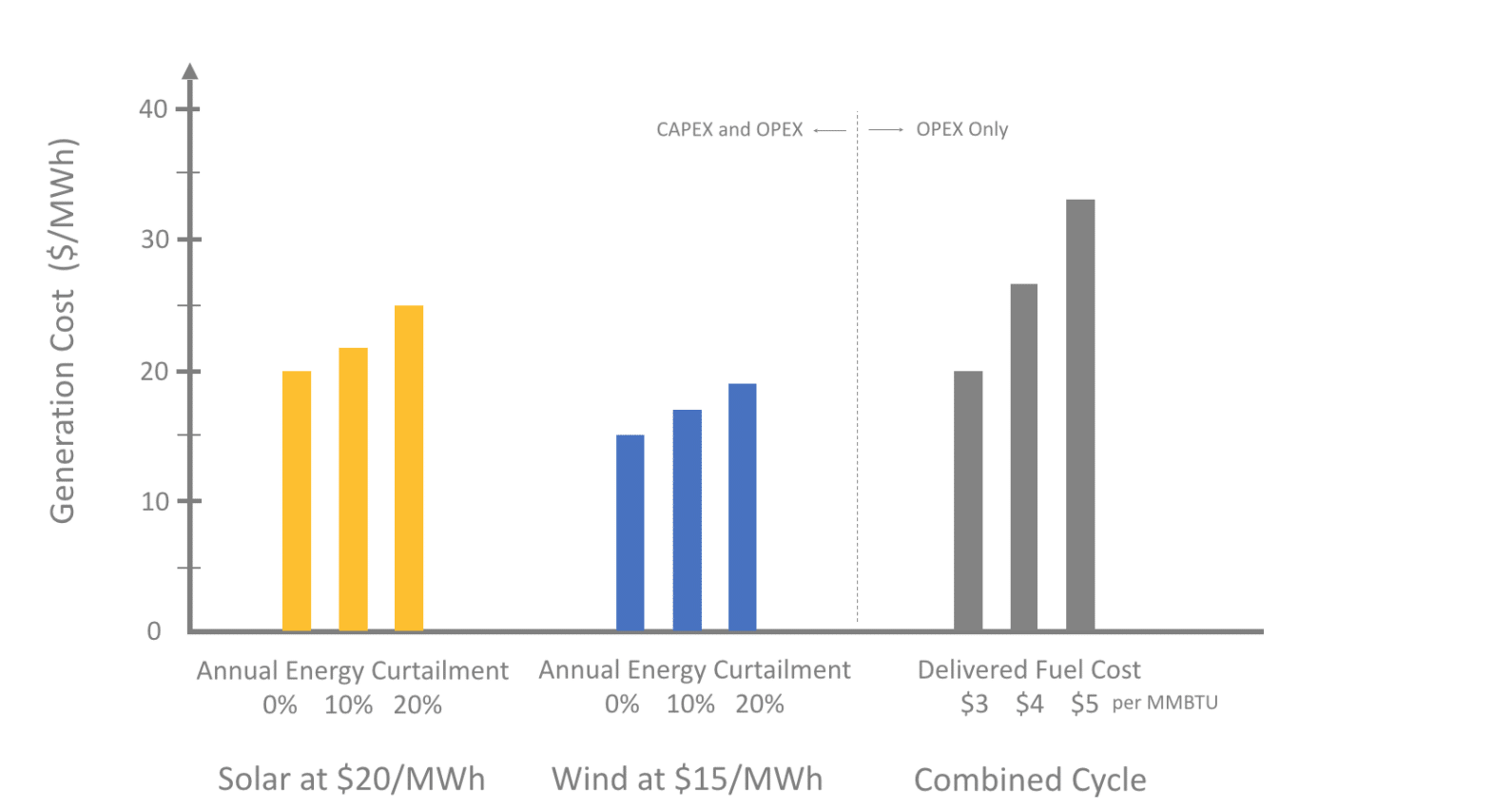
Step 5: Plan for Free Energy!
The easiest part of economic curtailment to embrace is a future where energy is periodically free. Given the future cost structures described above, solar and wind will deliver an excess of energy, relative to load, for a meaningful number of hours each year. Barring the development of seasonal energy storage (which has a number of challenges), this future will be true even after accounting for load shifting and diurnal energy storage.
If I were a university professor or a member of a national lab, I would be thinking hard about ways to utilize free energy during periods of excess renewable production. Researchers at the University of Minnesota have already found ways to use excess wind energy for the production of ammonia for fertilizer (as described here). Such an invention would be highly useful in the Midwest where there is both an abundance of wind production and fertilizer consumption.
Similarly, California could use excess solar production to produce fresh water for the LA basin. This would greatly reduce the amount of water that would otherwise be diverted from California’s central valley, a key agricultural center for California and the United States.
I have no doubt that the above are only two of the many uses we will find for free or ultra-low cost renewable energy.
This content is protected by copyright and may not be reused. If you want to cooperate with us and would like to reuse some of our content, please contact: editors@pv-magazine.com.
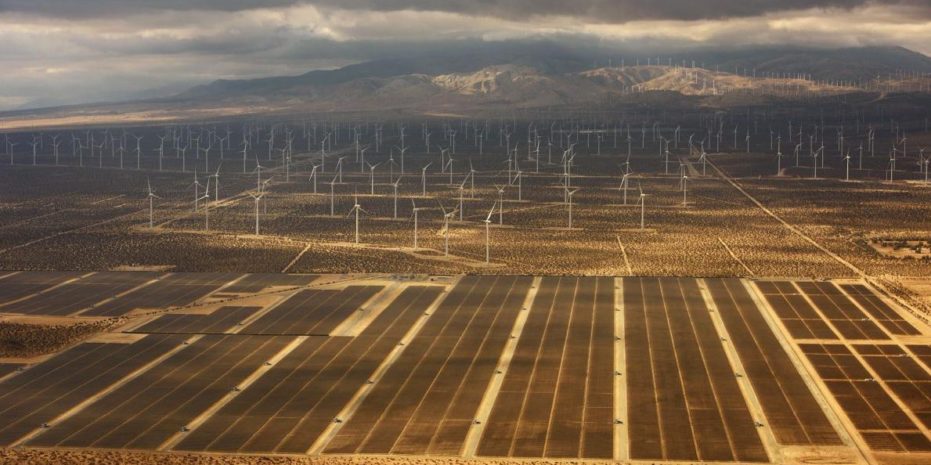







Hydrogen production for industry as mentioned, or transport, for use in gas turbines, and eventually for heating in a completely zero-carbon gas network.
Piping hydrogen via plastic or polymer pipelines is much cheaper and easier than electricity infrastructure. Electrolysers are also reducing in cost to the extent that a utilisation rate of only 25% is now possible.
Electrolysers are approaching $500/kW and are already $200/kW in China, with BNEF predicting that this cost will drop to $100/kW in many regions by 2030.
“My experience is that many utility employees quickly realize that the economic curtailment of excess renewable energy isn’t so terribly different from the use of gas peakers. Gas peakers and some other generation assets are designed to be operated with utilization factors well below 100%. In fact, gas peakers are used roughly 5% of the hours in a year. As a result, utility employees appreciate the idea of overbuilding renewables to ensure sufficient capacity when resources are low (relative to load).”
Interesting point, the operators don’t see a difference between curtailing non-fueled generation and gas Peaker plants. “Operated” in this manner the ratepayers also don’t see the insanity of shutting down non-fueled wind and solar PV and still having to buy spot contracts for fueled generation to ramp around grid needs. It’s no big deal for “operators” to shut down a solar PV or wind generation plant. From a resource availability per cost prospect, the operation is inefficient and trapped in an old business model that costs the ratepayers more than it should for energy that is available and instead of being stored it is “curtailed”. All of these Universities with teraflops of calculation ability, NREL, ORNL and no one has dared to project how much money is wasted by “curtailing” alternative energy (non-fueled) over generation, while contracting for fueled generation to ramp around grid demands, instead of installing regional and local energy storage with the same capital being used to construct natural gas Peaker plants or natural gas retrofits to old coal fired plants. Energy storage has been proven as an asset that can stack grid services and create a revenue stream by being used for grid frequency regulation, grid voltage regulation, grid energy storage and shifting for use later in the day and something a gas Peaker plant can’t necessarily DO. Say there’s an industrial complex that has many manufacturing facilities from plastics injection molding, to bottling and canning operations, waste water treatment plant, recycling plant and other operations. This industrial park is typically a 8AM to 5 PM operation. At 8AM a large grid power spike is sensed when many of the manufacturing plants come full online for the days production. A large energy storage facility at the edge of such an industrial complex can react to the many motors, lights, fans, conveyor belts starting up creating current surges and a sag on the grid. In milliseconds to a couple of seconds, the energy storage system could supply the current surge, regulate the grid and regulate the grid frequency with a short burst of MW of power. Makes the Peaker plant worthless and the energy storage worth much more and more useful during the daily demand on the grid.
The basic “wisdom” is energy storage is to expensive. IF (properly) evaluated, one could have a tool that would determine, where energy storage could be installed in a grid system, how much energy storage would be needed, how long the energy storage with ancillary revenue streams would take to pay for itself. Proper placement of the asset, asset sizing, asset component costs and actual present and future capacity of the energy storage facility all have a value above and beyond a price per MW of generation or storage capability.